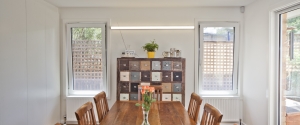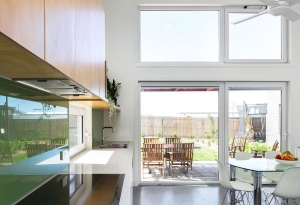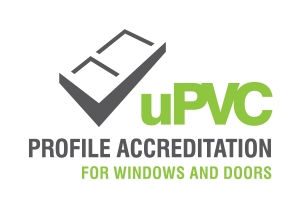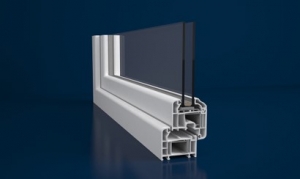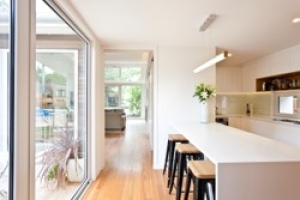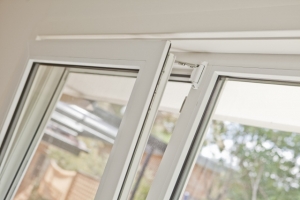VCA calls for reassessment of uPVC window frames in NCC 2022
The Vinyl Council of Australia is pressing the Australian Building Codes Board (ABCB) to exempt uPVC window frames and sashes from non-combustibility requirements in the National Construction Code (NCC) Volume One (Clause C2D10).
In its Proposal for Change, the Council is seeking to modify the Deemed-To-Satisfy (DTS) requirements with a concession for window sashes and frames from the non-combustibility requirements for external walls of buildings over three storeys.
In support of its submission, the Council highlights evidence showing that uPVC (unplasticized or rigid PVC) window frames do not pose a significant risk of accelerating the spread of fire on an external wall compared to a non-combustible, or metal, frame.
Furthermore, the acceptable Verification Methodology CV3 for assessing external walls, AS 5113:2016, is not designed or suitable for testing the fire performance of window frames.
Without a DTS solution, it effectively means that uPVC and timber window frames can no longer be used in some residential buildings of three storeys or more without a Performance Solution being commissioned for the specific project.
“Evidence shows uPVC window frames and sashes make negligible contribution to the spread of a building fire on external walls due to the relatively small material contribution from window frames and the self-extinguishing nature of uPVC. Physical fire testing overseas has shown that uPVC exhibits good fire resistance values,” says Sophi MacMillan, Chief Executive of the Vinyl Council of Australia.
“The change is proposed on the basis that the non-combustibility test excludes some materials that would not be expected to propagate fire, nor contribute significantly to the fuel load of an external fire or the spread of fire on the facade but have other desirable energy efficiency and acoustic insulation properties.”
She points out that the current Deemed-to-Satisfy provisions in NCC 2019 Volume One provide concessions for other elements of the window, such as glass, sealants, gaskets, caulking, and thermal breaks associated with glazing systems. The Public Comment Draft of NCC 2022 adds additional combustible window and glazing elements such as construction packers and compressible foams, but not the frames.
Radiant heat from a building façade fire will likely cause these concession elements and the glazing to fail before the frame does, which allows embers to enter the interior and ignite window furnishings or any other combustible materials adjacent to the window.
Recently, several jurisdictions have reviewed and, in some cases, tightened external wall non-combustibility requirements following major building fires, such as the 2017 fire in the 24-storey Grenfell Tower, London. However, exemptions or concessions for uPVC window and door frames have been confirmed on the basis that combustible frames would not be expected to propagate a building fire or add a significant amount to the fuel load of an external wall fire.
The Council argues that enabling the concession for window frames in the NCC 2022 will improve design choice and the transition towards higher performing windows without compromising fire safety.
In Europe and North America, uPVC windows are the most specified type due to their exceptionally good energy efficiency performance, Sophi points out. “Here in Australia, the overly restrictive requirements under the current NCC DTS provisions limit the opportunity for the construction industry to transition to well-proven, higher-performing windows from an energy and acoustic insulation perspective.”
The Building Code is generally amended on three-year cycles with the Public Comment Draft of the NCC 2022 released for consultation in May 2021.
In early April, the Council heard that their Proposal for Change was not accepted for inclusion in the Public Comment Draft of the 2022 Code.
Sophi adds: “This is disappointing news and means a substantial delay for us in addressing this issue before the next update in 2025. Many buildings and their residents seeking to retrofit energy efficient windows will now be disadvantaged.
“Our efforts are now focussed on gaining further supportive evidence for the suitability of the change, including more appropriate test methodologies for assessing the fire safety of window frames.
“Of course, we want to ensure buildings are safe in the event of a fire. However, a uPVC window frame does not pose a significant risk of accelerating exterior surface flame spread compared to a non-combustible window frame.
“The increasing use of uPVC over the last six decades in construction has led to a thorough assessment of its fire performance that attest to the safety of its use.”
For more information contact 03 9510 1711 or email This email address is being protected from spambots. You need JavaScript enabled to view it.
uPVC windows help to heal the ‘wound in the wall’
In Australia, we love our windows for bringing natural light into our homes – the bigger and more of them, the better. But when it comes to insulation – keeping heat either in or out, many of these windows are not as energy efficient as they could be. Here we explain how higher-performance uPVC windows can help to deliver that all-important cost-effective solution.
Improving the energy efficiency of new construction and existing residential buildings in Australia has been gathering momentum in recent years. Cutting down the carbon footprint of our built environment and reducing carbon emissions is seen as a vital contribution towards fighting climate change.
Adding insulation to walls has been seen as a relatively cost-effective way of improving the star energy efficiency rating of new builds and renovations. However, by creating ‘holes’ and thermal bridges in the building fabric, it is windows that are a major source of compromise in the thermal performance in the building. A glazed wall makes your house more difficult to maintain a comfortable temperature all year round. It is like an ‘open wound’ – either leaking or absorbing too much heat, depending on the season.
So, how do we try to heal this ‘wound in the wall’? To understand how poor-performing windows leave a gaping ‘hole’ in an insulated wall, we have to consider how insulation and conduction of thermal energy is measured to compare the two structures – walls and windows.
Wall insulation is usually given in R-Values – a measure of how much an insulation structure will resist the flow of thermal energy over a two-dimensional surface. Windows are rated in U-values (the inverse of R-value) – how much an insulation product will conduct, or lose, heat. So, if we want to compare the window to the insulated wall, we can convert the U value to the R Value.
People are used to hearing about wall insulation R values but may be less familiar with U values for windows. A large, glazed area in an Australian home typically has a U value of 6, equivalent to an R value of 0.15, whereas wall insulation is expected to have an R value of 1.0 to 2.5 depending on climate zone.
For the Victorian climate, the government authority Sustainability Victoria’s recommendation for wall insulation R value is R2.5, with a minimum requirement of R1.5. So, that glazed wall or large window would really struggle to cope with keeping in, or rejecting, heat.
A glazed area will leak heat in winter and allows heat into the interior in summer leading to uncomfortable interior temperatures. What we need is for the glazing to be better insulated, like the wall. That means a lower U value for the windows and glazed doors with a more air tight seal.
While they enhance natural light levels, windows are much less efficient than insulated walls at keeping temperatures stable and sustainable. Nearly 40% of all energy loss from buildings is through windows and doors and up to 87% of building heat can be gained through windows.
Various measures can improve a window’s efficiency. Consider double-glazed panes, reflective low-emissivity coatings, insulating gas (argon) between the glass panes, and tightly sealed uPVC frames that reduce air infiltration between the sash and house frame. Unlike aluminium, uPVC does not conduct heat. In fact, uPVC is 1,000 times less conductive than aluminium.
The lower the U value of the window (and therefore the higher its R value), the more insulation it will provide – keeping you warmer in winter and cooler at the height of summer. Most double-glazed uPVC windows in Australia have U values below 2.2, providing effective and thermally efficient insulation against extremes of both heat and cold, resulting in more stable, comfortable interior temperatures.
According to the CSIRO’s Housing Data Portal, although a growing number of new builds are installing higher performing windows, two thirds of new builds and apartments in 2019 still had windows installed with U values higher than 4. This is a concern as it is locking in poor thermal comfort and energy inefficiency for a long time into the future.
It is, however, welcome news to see the specific reference to uPVC windows for higher performance in some of the free architect-designed plans and base specifications for homes to achieve a minimum 7 Star NatHERS rating in a range of climate zones. The plans have been produced by the Australian federal government and can be accessed through the Department of Industry and Science’s YourHome.gov.au website.
For example, using double glazed uPVC windows in the four-bedroomed ‘Telopea’ home, designed for the Melbourne climate, would achieve a top 7.1- or 7.2-Star rating in terms of energy efficiency. Energy efficient windows make your home more comfortable, dramatically reduce your energy costs and help to create a brighter, cleaner and healthier environment.
Given the high profile of climate change issues and the urgency of addressing climate change-inducing emissions, the thermal-efficiency benefits of higher performing uPVC windows have a serious role to play in improving the residential energy efficiency of our buildings for decades to come. And to help mend that ‘wound in the wall’.
Technical report highlights good fire performance of PVC
PVC used in windows and building products has proven performance benefits in the event of fire due to its inherent flame retardancy, that will not cause, support or enhance the development of fire. Sophi MacMillan, Chief Executive of the Vinyl Council of Australia analyses the latest technical guidance on PVC fire safety.
PVC, or vinyl, is the most widely used polymer in building and construction applications with up to 70% of global annual PVC production used in this sector. Plastic products contribute to greater building energy efficiency, cost savings, construction safety, lower embodied carbon and design versatility.
The material’s increasing use over the last six decades in construction and furnishing of buildings has led to a thorough assessment of its fire performance that shows the distinct advantages of uPVC (unplasticised or rigid PVC) over many other building materials, including timber, in the event of fire. Crucially, PVC, especially unplasticised PVC (uPVC or PVC-U) has inherently superior fire performance due to its chlorine content that acts as a natural fire retardant, setting it apart from other polymers such as polyethylene.
Specifiers, architects, construction and fire professionals can learn more about the material’s credentials in the 2019 ISO Technical Report: ‘Plastics – Guidance on fire characteristics and fire performance of PVC materials used in building applications’, which serves as a valuable technical reference document for the specification of PVC products at the design or pre-building phase.
So, what are the benefits of PVC fire performance characteristics and how can these contribute to enhanced safety in the event of fire?
uPVC is inherently fire retardant: The high chlorine content of uPVC acts as a natural flame retardant, greatly reducing its combustibility. Unlike most timber building elements, uPVC building elements (such as window frames and permanent formwork) do not support combustion and are in fact self-extinguishing. In reaction to fire tests, the report states that due to its high content of chlorine, ‘PVC-U displays a high resistance to ignition, a low rate of heat release, and self-extinguishes when the external heat source is removed’.
uPVC is slow to ignite: uPVC is far less likely to burn due to its resistance to ignition, thus contributing to fire safety. The temperature required to ignite uPVC (391 degrees C), such as that used in window profiles and permanent formwork, is higher than that needed for wood (260 degrees C).The report’s comparison data of some results for PVC with those of other materials regarding ignition times and heat flux values to cause ignition respectively ‘illustrate the good ignition resistance’ of PVC materials.
uPVC is self-extinguishing: Most PVC formulations are not just difficult to ignite - they will self-extinguish when the flame source is removed because of the high levels of chlorine present in PVC. This makes PVC particularly suitable for rigid applications such as windows, doors and permanent formwork & lining used in construction, and is a significant positive for fire safety.
uPVC has a limited flame spread compared to other materials: Burning uPVC chars and will self-extinguish if the external heat or flame source is removed, making it inherently resistant to flame spread. It rarely produces flaming droplets or burning debris, which are a major cause of flame spread. Generally, uPVC profile has a low flame spread index (FSI) value of 15 to 20. In comparison, Douglas fir/cedar plywood FSI value is much higher at 190-230.
uPVC permanent formwork systems have been tested to AS5113 (BS8414) façade test and successfully passed the no flame spread criteria, and tested to AS1530.3 to achieve Spread of Flame Index of 0.
uPVC heat release: Heat release is a key factor regarding fire safety. Data on measurement of peak heat release rates (PHRR) and fire performance index (FPI) values shows that PVC materials ‘behave well’ when compared to other polymers and timber.
For example, uPVC permanent formwork systems have been tested to AS1530.3 to achieve Heat Evolved Index of 0.
In room-corner fire tests on wall-lining materials, the PVC systems outperformed the others, including wood, polycarbonate and FR ABS, with substantially lower average and total heat release rates. None of the PVC materials caused flashover. The study also showed that the low flame spread/low heat release characteristics of PVC materials tend to also exhibit low smoke release.
uPVC smoke density and toxicity in fires: Burning PVC releases a heavy smoke. However, smoke measurement tests show that PVC materials do not present a significantly greater smoke hazard than many other commonly used materials.
PVC and fire safety. In the context of fire safety objectives, survey data shows that only 10% to 15% of all plastics in a private house are in construction products. A much higher proportion (85% to 90%) of plastics are brought into a building by the occupants, such as furniture, household and technology appliances, toys and packaging.
As a strong, recyclable and versatile building material, with inherent fire retardancy, PVC is an excellent safe and long-life choice for myriad construction applications.In Australia, uPVC window frames have been developed and tested specifically to meet construction requirements for designated Bushfire Attack Levels (BAL) within Australian Standards for Construction in Bushfire Prone Areas (AS 3959:2009). And uPVC permanent formwork systems can meet BAL FZ (flame zone) construction requirements.
uPVC windows with metal reinforcing are permitted in zones classified as up to BAL-29 (where the number represents the heat flux in kW m²) risk. Some u-PVC window systems have been independently tested and comply with AS 1530.8.1 which permits their use in zones BAL-40 and above.
While people are, naturally and rightly, concerned about combustibility of plastics, it is important to understand the difference between the characteristics and properties of different polymers. And crucially, that PVC’s high chlorine content (57%) - a fire retardant -sets it apart from other polymers.
Australian manufactured uPVC permanent formwork systems have extensively been fire tested to demonstrate their fire performance compliance with the relevant requirements of the NCC. These fire tests include (but are not limited to) AS5113 (BS8414) façade fire test, AS5637.1 (ISO9705) room test classification test, AS1530.4 fire resistance level testing, and AS1530.3 fire hazard indices test.
PVC is undoubtedly one of our most successful modern synthetic building materials that has undergone rigorous assessment on its effect on health and the environment. It is time to reassess our attitudes towards this proven safe material.
Plustec is the first uPVC window profile supplier to achieve national industry accreditation
Vinyl Council member, Plustec Pty Ltd, based in NSW, has become the first uPVC profile supplier to achieve accreditation under the country’s Industry Code of Practice (ICP) for vinyl profiles used in windows and doors in Australia. The company is also one of only two companies that extrude uPVC window profiles locally.
Developed by the Vinyl Council of Australia, the uPVC Window Alliance’s initiative is designed to provide greater confidence to specifiers, builders and consumers in the durability of uPVC profiles under Australian climatic conditions and to reduce concern that uPVC profiles may discolour under high UV conditions.
The ICP sets specific composition, weathering resistance, colour and strength requirements for extruded uPVC profiles for use in windows and doors in Australian buildings. Assessments of profile performance to the ICP requirements are made by third party accredited testing laboratories and require physical exposure of the profiles to one of the highest UV radiation exposure standards for these products in the world. This means that purchasers of Australian-made u-PVC window and doors holding this new accreditation can be confident that the products have been tested to withstand Australia’s higher UV conditions.
Sophi MacMillan, Chief Executive of the Vinyl Council of Australia comments: “Through our uPVC Window Alliance initiative, all local uPVC profile suppliers supplying products in Australia who achieve this trade mark have demonstrated that their products can reliably meet the highest standards required, both to meet our more extreme climatic conditions and those expected by prospective purchasers.
“Consumers in Australia buying uPVC windows expect, quite rightly, that these can cope with a harsher climate. That’s why we have introduced the new testing requirements and trade mark with stringent compliance requirements to provide customers with greater confidence in the durability of uPVC products in Australian climatic conditions.
“We not only encourage people to choose uPVC windows for quality high performance windows, we encourage them to ask for this mark.”
Tracy Wakefield, Managing Director of Plustec comments: “As a small company, we are extremely proud of this ‘trailblazing’ achievement that has taken considerable time to go through the rigorous testing regimes. It is exciting that the first accreditation is for an Australian-made product.
“We designed our profile specifically for the Australian market and the ICP accreditation endorses our efforts to make a profile specifically suited to Australia’s needs. It makes our effort worthwhile!”
The use of uPVC (unplasticised PVC, or vinyl-framed) double-glazed windows has been growing in Australia as they not only perform well in keeping cold out of a building and heat within; they also work to keep summer heat out and the cool air inside.
Well-established in Europe, the UK and US, where they are the dominant window type used, a key benefit of uPVC high performance windows is their ability to balance optimisation of heating and cooling loads with consumers’ desire for greater natural light.
The excellent thermal insulation of the uPVC frames combined with insulated glass units and airtight sealing mean less energy is needed to maintain an ambient temperature within the home, which is reflected in cost savings, lower energy bills and improved levels of comfort. This makes them an ideal energy-efficient and cost-effective solution for Australian homes where homeowners like large areas of glazing and plenty of natural light.
Given that Australia has the highest solar radiation per square metre of land of any continent, it is important that products used in Australian buildings are formulated and designed for the climate. The ICP for uPVC window and door profiles is much higher than even the ‘Severe’ climate test for warmer parts of southern Europe, the US or China.
Suppliers seeking ICP accreditation must have their profiles independently tested near Townsville, Queensland, Australia’s only natural outdoor weather resistance testing laboratory. The ICP also covers polymer quality and restrictions on legacy additives, while allowing recycled PVC to permitted levels.
Sophi adds: “Congratulations to Plustec on being our first fully accredited supplier of uPVC profiles for the Australia market. We look forward to welcoming other profile suppliers seeking to achieve the mark and, in turn, offering weathering resistance confidence to their customers here.”
Why Australians should choose higher-performing uPVC windows
Windows play a vital role in regulating temperatures of buildings and their overall energy efficiency, whatever the climate. Energy efficiency is not just about preserving heating in homes in winter; it is also about minimising and preserving artificial cooling in summer.
Today, high-performance windows are increasingly gaining acceptance in Australia as rising energy costs are prompting homeowners to consider the role of windows in their homes.
uPVC (unplasticised PVC, or vinyl-framed) double-glazed windows not only perform well in keeping cold out of a building and heat within; they also work to keep summer heat out and the cool air inside.
Well-established in Europe, the UK and US, where they are the dominant window type used, a key benefit of uPVC high performance windows is their ability to balance optimisation of heating and cooling loads with consumers’ desire for greater natural light.
The excellent thermal insulation of the uPVC frames combined with insulated glass units and airtight sealing mean less energy is needed to maintain an ambient temperature within the home, which is reflected in cost savings, lower energy bills and improved levels of comfort. This makes them an ideal energy-efficient and cost-effective solution for Australian homes where homeowners like large areas of glazing and plenty of natural light.
Research by the CRC for Low Carbon Living reveals that 87% of consumers want a home filled with natural light and 85% want a cool home in summer and a warm home in winter. According to uPVC Window Alliance members, higher-performing window systems (where the U value of the window is less than 2.5W/m2K) are now available in Australia that outperform basic double-glazed windows for a similar cost.
Research conducted by Climate Works for a report, Built to Perform: An Industry Led Pathway to a Zero Carbon ready Building Code, published by the Australian Built Environment Council (ASBEC) in July found that double-glazed windows are one of a number of simple measures to improve building performance that would be cost-effective if undertaken today to meet proposed stronger energy efficiency requirements of Australia’s National Construction Code. The analysis found that upfront costs of such measures would be more than offset by the energy bill savings, reduced spend on heating, cooling and ventilation equipment, and electricity network savings.
Modern uPVC windows are made from a rigid and dense material that is used worldwide for a variety of building products. The multiple chamber construction of uPVC windows gives them excellent thermal performance and strength, plus the frames’ low conductivity limits the transfer of heat and cold. uPVC is roughly 1,000 times less conductive of heat than aluminium. Thermal performance is further enhanced by a minimum 12mm air gap in the insulated glazing unit commonly found in uPVC windows.
Advances in PVC formulations, including a ‘tropical’ version for extreme heat and UV, have improved resistance to environmental conditions, such as heavy rain, warping, cracking or splitting, making uPVC windows a sound choice for Australian and New Zealand climates. With high resistance to weathering, salt-corrosion and termites, low-maintenance uPVC windows are also an excellent choice for coastal locations.
Today’s uPVC windows not only perform well, they look good, are available in a range of colours and offer superior security, thanks to advances in hardware and locking systems. Commonly used in Europe, the tilt-and-turn opening system provides great versatility for ventilating the house and ease of cleaning from inside the building. For example, in tilt mode, the top of the window tilts forward into the room venting hot air outside while preventing cool air nearer the floor from escaping. The tilt function allows ventilation at night with the peace of mind of security.
Moving the handle into the next position enables the window to be fully opened like a hinge door, allowing for cleaning or additional ventilation. Also available is a tilt-and-slide system with similar sealing properties to the tilt-and-turn versions, but better than the standard sliding windows, which rely on brush seals (which keep bugs out, but not air).
Quality uPVC windows have a lifespan comparable to that of aluminium and are recyclable at end-of-life. With their in-built thermal-efficiency, they are up to 40 per cent more efficient than a standard aluminium window, making them a worthwhile investment in today’s energy-conscious world.
With more window companies offering uPVC windows in Australia amid a growing market, they are becoming an affordable and sustainable fenestration choice for 21st century living.
Working towards Net Zero makes economic, environmental sense
The Vinyl Council of Australia welcomes the findings of a new report that shows stronger energy standards in Australia’s National Construction Code can be delivered cost-effectively for new home owners and will help Australia cut its carbon emissions.
The report, Built to Perform: An Industry Led Pathway to a Zero Carbon Ready Building Code, prepared by the Australian SustainableBuilt Environment Council (ASBEC) and ClimateWorks Australia, analysed and identified measures that would be cost-effective in improving the energy efficiency of buildings relative to the upfront investment cost.
By 2030, improvement in Code energy requirements could deliver between 19 and 25 per cent of the energy savings required to achieve net zero energy in new residential buildings through simple, cost-effective measures such as improved air tightness, double glazed windows, increased insulation, outdoor shading, and more efficient air conditioners, hot water systems and lighting.
Although there are upfront costs associated with these improvements, they are small (less than 4% for detached homes) relative to overall construction costs and land prices while providing ongoing benefit for occupants.
“Australia lags other regions around the world in terms of building energy efficient homes” Vinyl Council Chief Executive, Sophi MacMillan said. “All of the buildings being built today will still be in use in 2050, potentially locking in poor performance at a time when much of the world will be at or near net zero emissions if current target projections are met.”
“We are particularly concerned by the continued use of very low performing windows in a country that loves large windows in its houses. Built to Perform is important in showing there are cost effective measures, such as double glazing, we can – and should – be implementing from today.”
The Vinyl Council also supports the proposition in the report that targets and a forward trajectory are set for future Building Code updates from 2019, with a clear and transparent process for implementation and adjustment over time.
“This approach would provide the certainty industries like ours – supplying thermally efficient uPVC windows and other building products - need to innovate and invest, so as to supply the economic products that higher performing buildings need”, Sophi explained. “This will support a rapid and least-cost, national transition to net zero.”
“Built to Perform clearly shows that cost-effective investment can be made from today to deliver long term improvements in residential energy demand and greenhouse emissions.”
Built to Perform provides industry-based evidence that the Code could, between now and 2050, reduce energy bills by up to $27 billion, cut energy network costs by up to $7 billion and deliver at least 78 million tonnes of cumulative emissions savings.
About the report
Built to Perform: An Industry Led Pathway to a Zero Carbon Ready Building Code presents the results of the Building Code Energy Performance Trajectory project, which quantifies the opportunities of establishing a clear, consistent and ambitious long-term plan for the energy requirements in the National Construction Code. The report modelled eight different building types across four climate zones. It investigated the costs and benefits to society of simple energy efficiency and on-site renewable energy opportunities. The analysis assessed upfront costs associated with improvements, as well as benefits from reduced energy bills, downsizing of heating, cooling and ventilation equipment, and reduced network costs.
This report was produced with the generous support of the Cooperative Research Centre for Low Carbon Living, the RACV and dozens of building industry and government partners. The project has been delivered in partnership with CSIRO, Energy Action (EA), Strategy. Policy. Research. (SPR) and the Sustainable Buildings Research Centre at the University of Wollongong (UOW).
The Vinyl Council of Australia is a member of ASBEC and one of the report’s industry partners.
Developing Affordable Passive Houses in Australia
A new house in a Melbourne suburban street has demonstrated that affordable Passive House construction looks within reach in Australia.
Until now passive houses were priced well beyond the means of ordinary Australians, and scared off both builders and home buyers. But retirees Sue and Peter, builder RMH homes, passive house certifier Grun Consulting, and uPVC windows supplier VUE Windows have produced an elegant, spacious home that looks like any normal new build. Unlike those normal new builds, however, the home will produce stellar results in terms of thermal comfort and energy efficiency. In doing so, they have opened the door to more affordable, comfortable, high performing homes in Australia.
The house features an expansive wall consisting of 32.45 square metres of uPVC double glazed windows and doors across the north-facing living and kitchen areas, including openable fanlight windows at ceiling height for purging hot summer air.
The argon filled double glazed uPVC windows achieve excellent insulation value of Uw 1.37 and a solar heat gain co-efficiency (SHGC) of 0.58, allowing winter sunshine to penetrate but not too much solar radiation in summer.
Read the full article about this house, published in Sourceable.net.
New recycling strategy for PVC in Australia
The Vinyl Council has updated its industry strategy aimed at facilitating growth in sustainable PVC recycling practices in Australia.
Developed through consultations with members, industry and government, and at the PVC ReSource Summit held in late 2015, the strategy will direct future actions of the Vinyl Council and the sector.
PVC - the third most commonly used polymer in Australia - is recyclable, however, results show that only low volumes of PVC wastes are recovered, largely because most PVC is used in durable products, and less in packaging (which is where most waste and recycling policies and resources are focussed).
The VCA estimates around 66,900 tonnes ofrecyclablePVC product goes to landfill each year. This is wasted material that could be reprocessed into new quality product by Australian workers and firms, improving Australian productivity, economy and the environment.
The VCA and its members are committed to advancing PVC recycling and reprocessing. The updated industry strategy aims to address barriers, to share knowledge, data and expertise and to encourage innovation of reprocessing, product design and recycling capability.
Key elements in the 2016 Strategy
There are six parts to the strategy and three especially form the foundation:
- Data and information. More data and knowledge are required for effective recycling of PVC.
- Collaboration between willing partners to drive change. Systemic change requires partners working together, and strong PVC reprocessing capability is required in all key States.
- End markets, without which there is no viable recycling practice. This requires building connections between demand and supply, development of appropriate recyclate-absorbing products and encouraging substitution of virgin or other less sustainable materials.
The VCA has established successful vinyl recylcing programs including the PVC Recycling in Hospitals program which is now in place at over 60 Australian hospitlas. The VCA thanks all those who contribute to the success of PVC recycling in Australia and looks forward to working with many to achieve the actions for improved results for Australia's recycling rate, productivity and manufacturing future.
For more detail on the Strategy contact the Vinyl Council's This email address is being protected from spambots. You need JavaScript enabled to view it..




